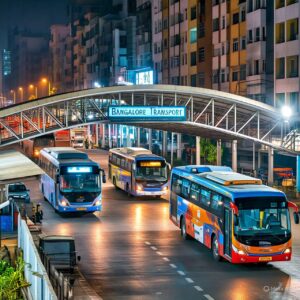Bangalore, often dubbed the “Silicon Valley of India,” is home to over 13 million people and thousands of tech companies, start-ups, and educational institutions. However, with this rapid growth comes a harsh reality—traffic congestion, overstretched transport systems, and daily commuter stress.
The city’s expanding boundaries and increasing reliance on private vehicles have created an urban mobility crisis. In response, technology-driven innovations like Yatra Sakhi, a real-time transit application, are stepping in to revolutionize public transport and offer long-term solutions to the city’s mobility woes.
The Traffic Dilemma in Bangalore
Traffic in Bangalore is more than a daily nuisance; it is a symptom of deeper urban planning issues. Key traffic bottlenecks such as Silk Board Junction, Whitefield, Electronic City, and KR Puram are infamous for hour-long delays during peak hours. Factors contributing to this situation include:
-
Rapid urbanization without proportional infrastructure development.
-
Overdependence on private vehicles leads to more cars and two-wheelers on the roads.
-
Inadequate last-mile connectivity discourages public transport use.
-
Lack of real-time information for efficient commute planning.
In a busy city where the need to travel is constant, whether to work, school, or markets, the absence of a smart, reliable public transport system not only hampers productivity but also contributes to pollution and a lower quality of life.
Current State of Public Transportation
The backbone of Bangalore’s public transport system is the BMTC (Bangalore Metropolitan Transport Corporation) bus network and Namma Metro. While both are used by thousands daily, they fall short in several areas:
-
Unpredictable bus timings and poor frequency in outer areas.
-
Overcrowded buses, especially during rush hours.
-
Limited integration between different modes of transport.
-
Lack of dynamic scheduling based on commuter needs and traffic patterns.
In short, while the infrastructure exists, its inefficiency and lack of smart solutions make public transport less appealing compared to private modes.
Why Bangalore Needs Smart Transit Solutions
Bangalore is a highly mobile city, with millions commuting daily across districts and zones. The city’s professional, student, and service sectors require a transportation system that is fast, predictable, and convenient. With working hours stretching beyond the traditional 9-to-5 window and frequent travel needs for everything from groceries to business meetings, Bangalore’s residents are heavily dependent on mobility.
The demand is clear: Bangalore needs technology-driven, commuter-focused transport innovations to improve its current systems, reduce congestion, and promote sustainable practices.
Introducing Yatra Sakhi: Smart Mobility in Action
Amid this scenario, Yatra Sakhi enters as a next-generation mobile application developed to transform Bangalore’s public transport landscape. Designed in alignment with the Government of Karnataka’s vision for a smarter city, Yatra Sakhi uses GPS integration, real-time data, and user-friendly features to enhance both commuter experience and government monitoring.
Key Features of Yatra Sakhi
-
Real-Time Bus Tracking
No more waiting at bus stops wondering when your bus will arrive. Yatra Sakhi offers live tracking of BMTC buses, giving commuters up-to-the-minute updates. -
Smart Route Planning
The app uses real-time traffic data and bus schedules to suggest optimal routes, saving time and minimizing delays. -
Seamless Navigation
Whether you’re new to the city or navigating a new route, Yatra Sakhi guides users from start to finish, including walking directions to the nearest stop. -
Fleet Monitoring for Authorities
The backend system helps government officials track bus movements, identify route delays, and optimize fleet deployment. -
Data-Driven Decision-Making
With usage data and traffic analytics, authorities can redesign routes, adjust timings, and make informed policy decisions to improve public transit. -
Operational Transparency
The app creates a transparent ecosystem where citizens and officials share the same information, building public trust.
Value to the Society
For Commuters:
-
Reduced travel time and stress
-
Increased confidence in public transport
-
Savings on fuel and parking costs
-
A cleaner environment due to fewer personal vehicles
For the Government:
-
Efficient fleet utilization
-
Lower operational costs through data-driven planning
-
Higher commuter satisfaction and public approval
-
A key step toward sustainable urban development
For the City:
-
Reduced congestion in high-traffic zones
-
Better air quality and reduced emissions
-
A step toward smart city goals under national urban policies
Revenue Model and Business Viability
Yatra Sakhi is built on a public-private partnership model, ensuring scalability and sustainability. Potential revenue streams include:
-
Government contracts for fleet integration and analytics dashboards.
-
In-app advertisements for local services and brands.
-
Premium services like personalized route tracking or travel history logs.
-
Data services for urban planning and private mobility partners.
With low upfront costs for users and high potential for integration with metro and e-mobility services, the platform is economically viable and scalable to other Indian cities as well.
Challenges Ahead
Despite its promise, Yatra Sakhi and similar innovations face a few challenges:
-
Digital literacy and adoption barriers among older or less tech-savvy commuters.
-
Dependence on stable GPS and mobile networks, which may be inconsistent in some regions.
-
Coordination with multiple government departments and transport unions.
-
Continuous maintenance and updating of backend systems.
However, with clear stakeholder collaboration and a phased rollout, these obstacles can be overcome.
The Road Ahead
To maximize the impact of smart mobility tools like Yatra Sakhi, Bangalore must focus on:
-
Public awareness campaigns to encourage app adoption.
-
Infrastructure upgrades, such as digital displays at bus stops.
-
Integration with metro services, auto-rickshaws, and last-mile mobility providers.
-
Government incentives for app-based commuting and reduced car use.
Conclusion
Bangalore’s public transport challenges are not insurmountable—they simply require the right mix of technology, policy support, and public engagement. Yatra Sakhi represents the city’s leap toward an intelligent, sustainable, and commuter-centric future. As the city continues to grow, innovations like these will be essential in creating a public transport system that is not only functional but also futuristic.


